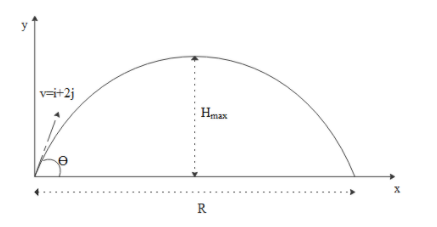
A projectile is given an initial velocity of $\left( {\mathop i\limits^ \wedge + 2\mathop j\limits^ \wedge } \right)m/s$ where $\mathop i\limits^ \wedge $ is along the ground and $\mathop j\limits^ \wedge $ is along the vertical. If $g = 10m/{s^2}$, the equation of its trajectory is
A. $y = 2x - 5{x^2}$
B. $4y = 2x - 5{x^2}$
C. $4y = 2x - 25{x^2}$
D. $y = x - 5{x^2}$
Answer
564.9k+ views
Hint: This is the case of projectile motion where the particle is projected with some angle to the horizontal. The acceleration acting on the projectile is only in vertical direction because gravity will be acting only in vertical direction and along horizontal direction there is no force.
Formula used:
$s = ut + \dfrac{1}{2}a{t^2}$
Complete answer::
When a particle is projected with some angle to the horizontal then that particle will have both horizontal displacement and vertical displacement. Since there will be no force along the horizontal direction the velocity along the horizontal direction will be the same throughout its motion while there is force along the vertical direction so velocity along vertical direction will vary.

We have the initial velocity equation as $\left( {1\mathop i\limits^ \wedge + 2\mathop j\limits^ \wedge } \right)m/s$ where initial velocity along x axis is $1m/s$ and along y axis is $2m/s$
Along the horizontal direction let the displacement be ‘x’ and initial velocity be ‘u’ and ‘t’ is time and acceleration is zero.
We have the equation
$s = ut + \dfrac{1}{2}a{t^2}$
$ \Rightarrow x = 1t + \dfrac{1}{2}(0){t^2}$
$\eqalign{
& \Rightarrow x = 1t \cr
& \Rightarrow x = t \cr} $
Along the vertical direction let the displacement be ‘y’ and initial velocity be ‘u’ and ‘t’ is time and acceleration is $10m/{s^2}$.
We have the equation
$s = ut + \dfrac{1}{2}a{t^2}$
Initial velocity in y direction and acceleration due to gravity(g) are in opposite directions. Hence we insert negative signs before ‘g’.
$ \Rightarrow y = 2t - \dfrac{1}{2}(10){t^2}$
$ \Rightarrow y = 2t - 5{t^2}$
Put $x = t$ in $y = 2t - 5{t^2}$ then we will get
$\eqalign{
& y = 2t - 5{t^2} \cr
& \Rightarrow t = x \cr
& \Rightarrow y = 2x - 5{x^2} \cr} $
The trajectory will be $y = 2x - 5{x^2}$
Hence option A will be the answer.
Note:
The formulas which we have are applicable only if the acceleration due to gravity is constant and not varying. We can find the trajectory by finding the range and the angle of projection with the horizontal and substituting it in the trajectory equation we have.
Formula used:
$s = ut + \dfrac{1}{2}a{t^2}$
Complete answer::
When a particle is projected with some angle to the horizontal then that particle will have both horizontal displacement and vertical displacement. Since there will be no force along the horizontal direction the velocity along the horizontal direction will be the same throughout its motion while there is force along the vertical direction so velocity along vertical direction will vary.

We have the initial velocity equation as $\left( {1\mathop i\limits^ \wedge + 2\mathop j\limits^ \wedge } \right)m/s$ where initial velocity along x axis is $1m/s$ and along y axis is $2m/s$
Along the horizontal direction let the displacement be ‘x’ and initial velocity be ‘u’ and ‘t’ is time and acceleration is zero.
We have the equation
$s = ut + \dfrac{1}{2}a{t^2}$
$ \Rightarrow x = 1t + \dfrac{1}{2}(0){t^2}$
$\eqalign{
& \Rightarrow x = 1t \cr
& \Rightarrow x = t \cr} $
Along the vertical direction let the displacement be ‘y’ and initial velocity be ‘u’ and ‘t’ is time and acceleration is $10m/{s^2}$.
We have the equation
$s = ut + \dfrac{1}{2}a{t^2}$
Initial velocity in y direction and acceleration due to gravity(g) are in opposite directions. Hence we insert negative signs before ‘g’.
$ \Rightarrow y = 2t - \dfrac{1}{2}(10){t^2}$
$ \Rightarrow y = 2t - 5{t^2}$
Put $x = t$ in $y = 2t - 5{t^2}$ then we will get
$\eqalign{
& y = 2t - 5{t^2} \cr
& \Rightarrow t = x \cr
& \Rightarrow y = 2x - 5{x^2} \cr} $
The trajectory will be $y = 2x - 5{x^2}$
Hence option A will be the answer.
Note:
The formulas which we have are applicable only if the acceleration due to gravity is constant and not varying. We can find the trajectory by finding the range and the angle of projection with the horizontal and substituting it in the trajectory equation we have.
Recently Updated Pages
Master Class 12 Business Studies: Engaging Questions & Answers for Success

Master Class 12 Economics: Engaging Questions & Answers for Success

Master Class 12 English: Engaging Questions & Answers for Success

Master Class 12 Maths: Engaging Questions & Answers for Success

Master Class 12 Social Science: Engaging Questions & Answers for Success

Master Class 12 Chemistry: Engaging Questions & Answers for Success

Trending doubts
What is meant by exothermic and endothermic reactions class 11 chemistry CBSE

Which animal has three hearts class 11 biology CBSE

10 examples of friction in our daily life

One Metric ton is equal to kg A 10000 B 1000 C 100 class 11 physics CBSE

1 Quintal is equal to a 110 kg b 10 kg c 100kg d 1000 class 11 physics CBSE

Difference Between Prokaryotic Cells and Eukaryotic Cells




